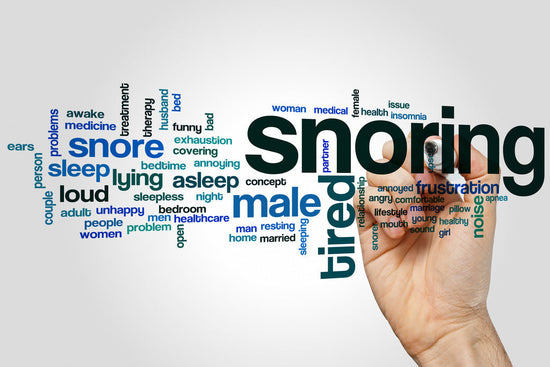
Sleep is essential for the growth and development of children. However, disturbances in sleep can lead to several complications, one of them being obstructive sleep apnea (OSA). As a serious sleep disorder, it's crucial to understand its complexities and explore the measures that can help alleviate it.
What is OSA in kids?
OSA is a condition marked by the temporary cessation of breathing during sleep due to the blockage of the upper airways. This obstructive nature results in fragmented sleep, snoring, and other symptoms that can impact a child's overall health and well-being. The next sections will delve into this complex disorder, its causes, symptoms, and effective treatment methods. (1)
Recognizing The Symptoms
Identifying the signs of OSA in kids can be challenging. These may include:
Loud or frequent snoring
- Pauses in breathing while asleep
- Sudden awakenings followed by gasping or choking
- Daytime sleepiness or behavioral issues
- Difficulty in concentrating during the day
- Dry mouth from mouth breathing at night
- Bed wetting
Causes of Obstructive Sleep Apnea in Kids
The primary cause of OSA in kids is the narrowing or blockage of their upper airways during sleep. This obstruction is often due to enlarged tonsils or adenoids. Other factors, such as obesity, genetic conditions that affect the structure of the face or throat, or certain medical and neurological conditions, can also contribute to the development of OSA in kids. (2)

Diagnosing Obstructive Sleep Apnea
Diagnosing OSA in kids often starts with a detailed analysis of their symptoms and a comprehensive physical examination. A sleep study or polysomnography may be conducted if a child's medical history and symptoms indicate possible OSA. This involves monitoring and recording the child's brain waves, blood oxygen levels, heart rate, and breathing patterns while they sleep. (3)
The Effects of Obstructive Sleep Apnea on Kids
OSA can lead to a series of adverse effects on children, including daytime sleepiness, irritability, and difficulty in focusing, all of which can impact their academic performance. Moreover, long-term consequences may include hypertension, cardiac problems, and growth retardation.
The Importance of Timely Intervention
Obstructive sleep apnea in kids is a condition that should not be ignored or taken lightly. Early intervention is essential to prevent further complications and ensure that children receive the restful sleep they need for optimal growth and development. (4)
Collaborating with Healthcare Professionals
If you suspect that your child may be suffering from obstructive sleep apnea, it's crucial to consult with a healthcare professional who specializes in sleep disorders. They will thoroughly evaluate your child's medical history and recommend appropriate diagnostic tests.
Monitoring Sleep Patterns
To better understand your child's sleep patterns and potential disruptions, keep a sleep diary. Note down the time your child goes to bed and wakes up and any observations you make during the night. This information can provide valuable insights to share with your healthcare provider. We have a free downloadable sleep diary you can use here.
Proven to Reduce Snoring: Treatment for Pediatric OSA
There are multiple ways to treat OSA in kids, all aimed at improving sleep quality, eliminating snoring, and promoting healthier growth and development.
Anti-Snore Device: The Non-Invasive Approach
One effective and non-invasive approach to managing OSA is the use of an anti-snore device. These devices work by positioning the jaw forward to keep the airway open during sleep, thus mitigating the chances of apnea episodes. Not only are they proven to reduce snoring, but they're also affordable snoring devices, making them a good option for many families.
Continuous Positive Airway Pressure (CPAP) Therapy
Considered the gold standard in treating OSA, CPAP involves a machine that delivers a constant stream of air through a mask worn during sleep. This continuous airflow keeps the airway open, effectively preventing apnea episodes and snoring.
Surgical Solutions
In some cases, surgical solutions might be necessary when non-invasive interventions don't offer relief. The most common procedure is adenotonsillectomy, the removal of the adenoids and tonsils, which are often the primary cause of airway obstruction in kids.
Lifestyle Changes
Encouraging a healthy lifestyle can also significantly impact a child's sleep health. This includes maintaining a healthy weight, establishing a regular sleep schedule, and avoiding exposure to secondhand smoke.
Encouraging Healthy Sleep Habits
While professional intervention is necessary, there are several steps you can take at home to promote healthy sleep habits:
-
Establish a consistent sleep schedule: Set regular bedtimes and wake-up times to help regulate your child's internal sleep-wake cycle.
-
Create a sleep-friendly environment: Make sure your child's bedroom is conducive to sleep. Keep the room dark, quiet, and at a comfortable temperature.
-
Limit screen time before bed: Avoid electronic devices, such as tablets or smartphones, for at least an hour before bedtime. The blue light emitted by screens can interfere with sleep.
- Encourage relaxation before bed: Engage in calming activities like reading a book or taking a warm bath to help your child wind down before sleep.
Stop Snoring Solutions: Finding What Works
The treatment plan for pediatric OSA is always individualized. While an anti-snore device may be effective for some, others might require CPAP therapy or even surgery. Discussing these options with a healthcare provider to find the most appropriate and effective solution for your child is crucial.
Conclusion: Don’t Ignore Snoring in Children
Snoring in children may seem benign, but it could indicate a serious condition like obstructive sleep apnea. Recognizing the symptoms, understanding the causes, and seeking professional help are crucial in safeguarding the health and development of your child. Today's stop-snoring solutions are diverse and effective, from lifestyle changes to anti-snore devices or even surgical procedures.
Remember, early detection and intervention can dramatically improve children with obstructive sleep apnea's quality of life. The steps you take today can pave the way for your child's healthier tomorrow.
No one should underestimate the power of a good night's sleep; every child deserves it. It's time we prioritize their sleep health and end disruptive sleep disorders like obstructive sleep apnea.
FAQ
How do I know if my child has OSA?
If you think your child might have obstructive sleep apnea (OSA), there are signs to watch for. They may snore loudly and frequently, have pauses in breathing during sleep, and sleep restlessly. OSA can make them feel very tired during the day, affect their behavior and concentration, and cause dry mouth from breathing through the mouth. Bedwetting may also be linked to OSA. It's important to see a doctor who can evaluate your child and recommend further tests, like a sleep study, to determine if they have OSA or another sleep issue.
Do children outgrow OSA?
Yes, children can sometimes outgrow obstructive sleep apnea (OSA). When kids have OSA because of enlarged tonsils or adenoids, their airways can improve as they grow older and these tissues shrink. But not all children outgrow it, especially if there are other causes. It's important to work with a doctor to monitor the condition and decide on the right treatment. Treatment may include lifestyle changes, like managing weight, using special devices during sleep, or even surgery if needed.
Can OSA occur in children?
Yes, obstructive sleep apnea (OSA) can happen to children too. It's when their upper airway gets blocked during sleep. This can be because of things like enlarged tonsils, obesity, or certain health conditions. Children with OSA might snore loudly, have trouble breathing while asleep, and feel tired during the day. If you think your child might have OSA, it's important to see a doctor for evaluation and tests. They can help figure out the best way to manage it and keep your child healthy.
What is the most common cause of OSA in children?
The most common cause of obstructive sleep apnea (OSA) in children is enlarged tonsils and adenoids. These are tissues located in the throat and behind the nose that can sometimes become too big, blocking the airway during sleep. When the airway is partially or completely blocked, it can lead to OSA. Other factors, like obesity, certain health conditions, or differences in facial structure, can also contribute to OSA in children. It's important to consult with a doctor if you suspect your child has OSA so they can determine the cause and recommend appropriate treatment.
How long is life expectancy with OSA?
It's important to treat obstructive sleep apnea (OSA) in kids because if left untreated, it can have serious effects on their health and potentially shorten their life by 12-15 years. Treating OSA will help alleviate its effects and ensure that it doesn't impact a child's life expectancy.





